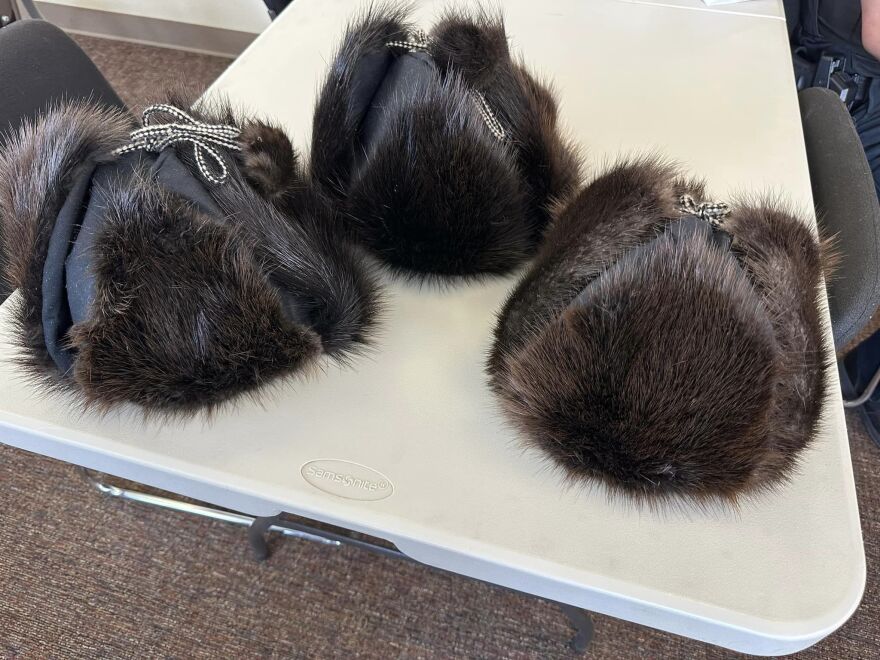For Alaska State Troopers and other police departments across the north, the fur trapper hat is iconic.
The State Department of Public Safety buys about fifty of them a year – and is looking for a new supply.
It has put out a request for proposals for hats with very specific requirements, that address the very challenges troopers face when their work takes them to icy snow machine trails and rural airports, often with no shelter from extreme crosswinds. But for Alaska State Troopers, the fur trapper hat is more than just head cover.
“Our uniform is rich in history and has a lot of meaning throughout the state,” said Austin McDaniel, communications director for the Alaska Department of Public Safety.
McDaniel says the fur hats have been part of the uniform for decades and over time, the standards have improved.
“We’re looking for a black hat that's made of otter or beaver fur, skull cap and ear covers that is insulated up to negative 40°F,” McDaniel said.
The hats must also be fleece-lined, both windproof and waterproof, and unisex.

McDaniel says troopers are still free to buy their own hats. About half of them prefer to have them locally made.
Earl Samuelson, a retired trooper pilot from Napaskiak, says after more than three decades with the department, he went through about five hats. He now volunteers for the Bethel Search and Rescue team, so a good hat is still important to him.
“Our area is harsh,” Samuelson said. “So you have got to have a really extreme cold weather hat.”
Samuelson, who is Yup’ik, says most of his hats, which are called “malagg’aayaqs” have been made by family. He says for the Kuskokwim River region, the trooper-issued fur hats are not warm enough for snow machine rides on the coldest days and are more suited to springtime wear.
“You don't have the correct hat or equipment. Yeah, you can freeze your ears,” he said.
It’s also important for your hat to have a tight fit. Samuelson says that’s why most troopers prefer to have their hats made locally, so they can be tailor-made. Even the tiniest leak can lead to frostbite. But Samuelson believes troopers also enjoy having a connection with Native skin sewers. He says the hats are a source of pride.
“People will ask you, well, who made your cap?” he said. “And you will say so and so, and so and so.”
Samuelson says most troopers prefer seal skin hats, because they’re not as heavy as those made out of beaver but are still warm and waterproof. But Samuelson believes beaver provides the best protection.
And that’s the fur four Fairbanks police officers chose, when they made their own beaver hats, with the help of elders at Denakkanaga, a Fairbanks-based non-profit. Although Denakkanaga means “Our people speak,” in the Athabascan language, there are not always opportunities for police to listen and share.
But last Spring, Denakkanaga offered its “Caps for Cops” program for the first time.
Sharon McConnell, the executive director for Denakkanana, says it turned out to be a remarkable cross-cultural exchange.

“By the end of the project, they were calling the elders that taught them, ‘Grandma,” McConnel said. “They even brought their kids to meet with the elders.”

McConnell says the hat-making project took place over the course of three sessions, which gave both the officers and elders a chance to get to know one another.
“The elders really treated them with respect, and the officers treated them with respect and really listened to what the elders had to say,” she said. “It's really important to build those connections, to build a rapport, not only to learn more about the area in which they're going to be serving, but also putting a human connection to the Native community. And so, it was really a win-win situation.”
Fairbanks Police Officer Clint Brubeck says he came away with a hat he’s proud to wear, one that is both “beautiful and functional.” He says it keeps him warm when his work takes him outside his patrol car for extended periods of time, but says his hat has become much more than head gear.
“I think the biggest takeaway from making those hats were the relationships built,” he said.

Brubeck worked with Marie Yaska, an elder in her 80s, originally from the Interior Athabascan community of Huslia. She nicknamed him “Broken Needles” in her language, because he broke two of her sewing machine needles.
Brubeck admits his workmanship is far from perfect but says every time he puts on his beaver hat, he thinks of the stories she shared with him – like how she learned to read by deciphering the letters on cardboard boxes that brought goods into the community, boxes that were also used for insulation – stories, he says, that are now a part of him and give him a sense of connection to the people he serves.
As for the State Troopers efforts to buy new hats, the deadline to respond to the state’s request for proposals to make the trooper hats is Friday.
The RFP doesn’t specify how many hats will be made but has an unusual proviso – that the vendors must provide two sample hats to be used for a 15-day test. The state says it will pay for damage outside normal wear and tear and will return the sample hats at no cost to the vendor.


